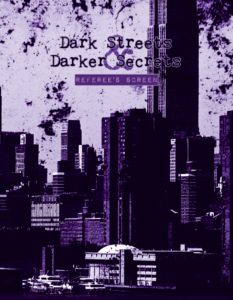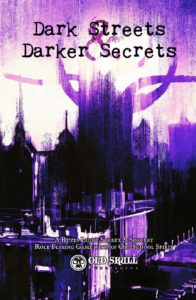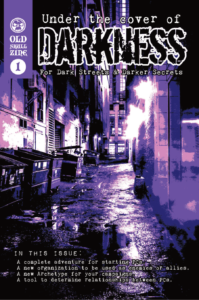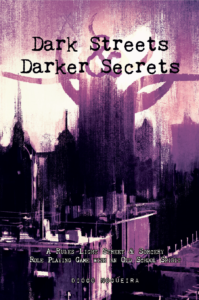
At a used book store in Nashville, I found a print-on-demand copy of Dark Streets & Darker Secrets by Diogo Nogueira. Produced and published through Old Skull Publishing and Gallant Knight Games respectively, this tabletop RPG advertises as a “Rules Light Street & Sorcery Role Playing Game With An Old School Spirit.” I read through it and, despite some challenges with the duel-system the game utilizes (more on that below), I picked up the PDF and I’m interested in writing about the good that can be found in these dark streets.
Building Your Character
 To understand character builds and the system, it’s worth noting that it’s an OSR (Old School Renaissance) d20-variant. Your character has four Attributes (Physique, Agility, Intellect, and Willpower) built from 2d6+3 so, starting out, your PCs have Attribute stats from 5 to 15. From those results, you derive the character’s Vitality (Hit Points), Sanity (used for dealing with the supernatural horrors of this world), Luck (an important stat because it’s used at critical moments), and Money (it’s abstracted).
To understand character builds and the system, it’s worth noting that it’s an OSR (Old School Renaissance) d20-variant. Your character has four Attributes (Physique, Agility, Intellect, and Willpower) built from 2d6+3 so, starting out, your PCs have Attribute stats from 5 to 15. From those results, you derive the character’s Vitality (Hit Points), Sanity (used for dealing with the supernatural horrors of this world), Luck (an important stat because it’s used at critical moments), and Money (it’s abstracted).
With those numbers locked, you create a concept, a starting complication, and match it to an Archetype (class). Archetypes determine your Recovery Roll (how many Vitality points you’ll recoup during a rest) and your special abilities. The Archetypes are The Tough (Fighter), The Nimble (Rogue), The Smart, and The Gifted (Wizard). In addition, the zine, Old Skull Zine #1, adds the Spirit Guardian Archetype allowing you to play a guardian animal.
Because I want to talk about the magic system, I’m going to focus on The Gifted Archetype. Starting out, The Gifted get three known powers, and three other starting abilities the biggest of which is having a bit of supernatural ancestry that gives them one bonus power like grandma was a vampire and if you consume human blood, you recover more Vitality.
The focus of The Gifted is the sorcery and psionic options. The game offers 60 sample powers, you can create more as needed. Every power requires you to spend Vitality points (equal to the difference in the level of the spell verses the level of your character) and make a Willpower Attribute test. If you succeed, the spell goes off. But what happens if a spell test goes wrong? If you roll above the Willpower Attribute test or below the Difficulty (more on that below), the spell fails and could face Backlash (damage) or or Corruption.
The Engine (for PCs)
 Spiritually, this RPG flows like D&D. However, the math is not D&D. What does that mean? It’s a d20 system, but with the twist that’s it’s a roll under/roll over gimmick for the PCs. Well, now, what does that mean? Everything is an Attribute Test in which you have to roll under or equal to your Attribute (5 to 15 at first level), yet roll over the Difficulty (0 to 5, generally). Difficulty is the roll over part of the PC’s roll under/roll over system. You have to roll at your stat or under, but above the Difficulty. A critical success is when you roll your exact Attribute score. A fumble is when you roll a natural 20.
Spiritually, this RPG flows like D&D. However, the math is not D&D. What does that mean? It’s a d20 system, but with the twist that’s it’s a roll under/roll over gimmick for the PCs. Well, now, what does that mean? Everything is an Attribute Test in which you have to roll under or equal to your Attribute (5 to 15 at first level), yet roll over the Difficulty (0 to 5, generally). Difficulty is the roll over part of the PC’s roll under/roll over system. You have to roll at your stat or under, but above the Difficulty. A critical success is when you roll your exact Attribute score. A fumble is when you roll a natural 20.
If you figure your average stat is 10 and the average difficult is 2, then you have a 40% of success each action.
For critical actions, you have the option to push the roll. This option allows you to re-roll an Attribute Test, but if you fail the re-roll the GM has unspecified carte blanche to do as they will to your PC. Obviously, using this option will be based on how your GM plays the game.
In DS&DS, Advantage and Disadvantage are renamed Positive and Negative Dice. This is a similar concept to the D&D 5e system in which you roll 2d20 but, because the PC’s use a roll under/roll over system, the player picks whichever die they want for the Positive (Advantage) and the GM picks whichever die they want if you’re rolling with an extra Negative die (Disadvantage).
By the by, if you’re GM’ing, bookmark page 47 (in the print version) of the core rulebook. That’s the page with the Powerful Opponent rule, a critical combat rule. It states that your Difficulty against an enemy is the difference between the PC’s level and the enemy’s Hit Dice. As well, when the enemy attacks, they add that difference to their rolls. That might sound like a player advantage, the difference adding to the NPC’s rolls, but this is where the duel-system that I mentioned above comes in: NPCs are on a roll over system. So lets talk about the NPCs using a different system than the PCs.
The Engine (for NPCs)
 For the NPCs, DS&DS is closer to the standard D&D roll over system. All of the PCs are rolling to get a target number in the middle of the range, However, that gets tossed out for NPCs and they use the traditional D&D mechanic: Higher is better. Here’s an example of how far apart the PC system is from the NPC system, remember when I stated that a PC’s critical success is rolling their exact Attribute score? It’s a roll of a 20 for an NPC. For a PC, a fumble is when you roll a natural 20, but it’s a 1 for NPCs.
For the NPCs, DS&DS is closer to the standard D&D roll over system. All of the PCs are rolling to get a target number in the middle of the range, However, that gets tossed out for NPCs and they use the traditional D&D mechanic: Higher is better. Here’s an example of how far apart the PC system is from the NPC system, remember when I stated that a PC’s critical success is rolling their exact Attribute score? It’s a roll of a 20 for an NPC. For a PC, a fumble is when you roll a natural 20, but it’s a 1 for NPCs.
Personally, I found having two systems in one game less than streamlined, but that’s me. This is right for fans of OSR who are looking for more crunch and by having a crunchier variation of the standard d20 formulas will be fun for some GMs. PCs learn a variation on the OSR-theme, while the NPCs use a better known version of the system.
The World
For this setting, it’s today but darker with hidden magic and supernatural elements. There are tables to build out your setting if you’re into random generation, but largely the world will be populated by GM direction. The upsides are you’re not bound by in-game lore and there’s support for areas in the world you may not have fleshed out in detail. But, if you’re looking for a setting, you’ll need to create it or lift it from another source.
Should You Travel the Dark Streets?
 While this game has two systems, one of the systems is D&D enough that you can run that in your sleep so it’s not a dealbreaker. The other system is D&D with the target number moved from the upper end of the die range to the middle of the range. If you’re an OSR GM looking for a few new tricks when rolling, this game is going to speak to you.
While this game has two systems, one of the systems is D&D enough that you can run that in your sleep so it’s not a dealbreaker. The other system is D&D with the target number moved from the upper end of the die range to the middle of the range. If you’re an OSR GM looking for a few new tricks when rolling, this game is going to speak to you.
Because of the ease of understanding the components of the system, I’m considered writing content for this game. That’s partially a reaction to the world, partially a reaction to feeling like I know the system enough to work with it, and partially because this game has an OGL. That’s right, if you’re looking for a modern setting OSR that allows you to create content for it (or convert existing content), there’s a compatibility license, Dark Streets & Darker Secrets Compatibility License. It’s a nice perk for this game.
Should you run these dark streets? I plan to and, if you’re looking for an OSR streets and sorcery RPG, this is the right call for you. Dark Streets & Darker Secrets by Diogo Nogueira is available through DriveThruRPG and Lulu. You can also get the Dark Streets & Darker Secrets GM Screen and Old Skull Zine #1, a zine with a new rule, a new archetype, an adventure, and more.
Egg Embry participates in the OneBookShelf Affiliate Program. This program provides advertising fees by linking to DriveThruRPG.
Latest posts by Egg Embry (see all)
- New Gamemaster Month 2023 - January 20, 2023
